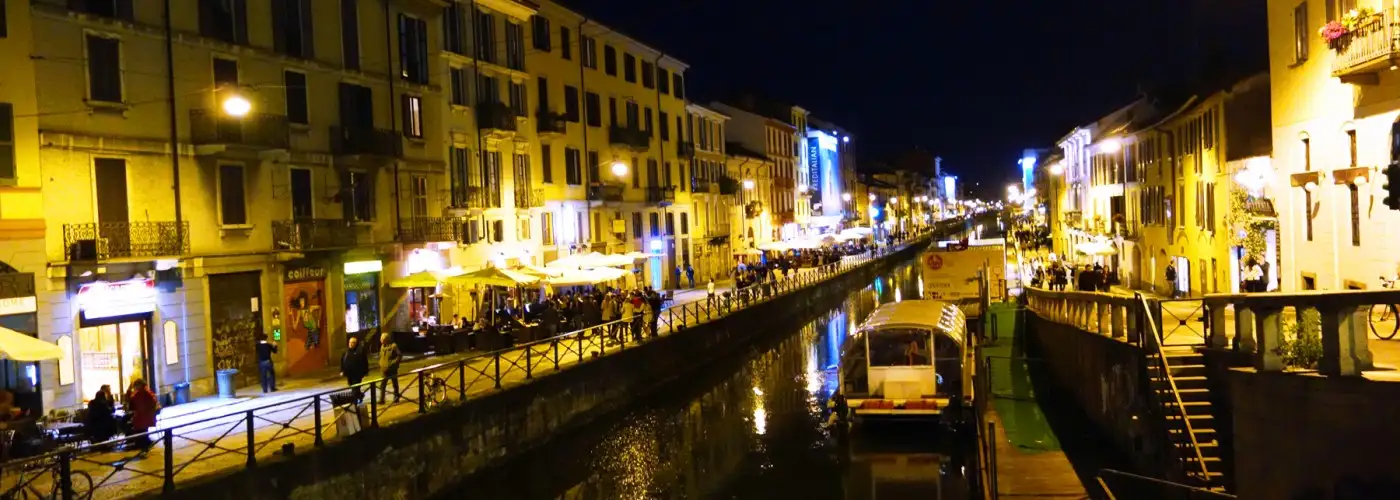They say that for every church in Rome, there’s a bank in Milan. The economic success of postwar Italy can be attributed, at least in part, to this city of bankers, publicists, and pasta power-lunchers.
Even though I’ve been coming to Milan for a long time, I still stumble onto great new sights every time I visit. A recent discovery is the “Big Canal”—the Naviglio Grande. Surprisingly, even though landlocked Milan is far from any major lake or river, the city has a sizable port. Since 1170, a canal has connected Milan with the Mediterranean via the Ticino River, which flows into the Po River on its way to the Adriatic Sea. Five hundred years ago, Leonardo da Vinci helped further develop the city’s canals and designed a modern lock system; you’ll find some of his exquisitely detailed drawings for the canals at Milan’s Biblioteca Ambrosiana.
Later, during the booming Industrial Age in the 19th century, the canals were used for shipping in the marble and stone needed to make Milan the great city it is. In fact, a canal (filled in during the 1930s) once circled the walls of the city and allowed barges to dock with their stone right at the building site of Milan’s grand cathedral.
Today, the old industrial canal district—once squalid and undesirable—is trendy and thriving. Former workers’ tenements are being snapped up and renovated by go-getter singles on the career fast track. With lively bars and restaurants lining the canal, this is a great people scene for dinner or evening fun.
Milan might have a reputation as Italy’s no-nonsense business and banking capital, but some locals still have a sense of humor. Piazza Affari, at the center of the financial district, is a knot of serious 1930s-era buildings in the heavy fascist style—except for the bold modern sculpture of a 36-foot-tall, marble middle finger punctuating the middle of the square.
Is it a towering vulgarism, or a commentary on the Italian fascist salute? (So claims its maker, Maurizio Cattelan—Italy’s most famous contemporary artist.) The head of the stock exchange was so offended by the disruption to the view from his Piazza Affari office that he moved to a nearby wing. “L.O.V.E.,” as the statue is entitled, was temporary at first. But most Milanese wanted it to stay, and by popular demand, it’s now permanent.
For contemporary art that’s better behaved, the Museo del Novecento is worth a look. In this beautifully laid-out building, escalators and a spiral ramp whisk visitors through the last century’s art, one decade at a time. The capper, though, is the stunning view from the top floor over the Gothic cathedral, newly gleaming after a head-to-toe restoration.
Milan’s people are themselves works of art. In this fashion-forward land where fur coats are still prized and cigarettes are chic, the people-watching is as entertaining as the window shopping. Fashionistas flock to the up-market shopping zone, the Quadrilateral, where shopping is a solemn business, usually conducted in small boutiques.
But for a different spin, it’s fun to wander the high-concept department store called Excelsior (in the Galleria del Corso). Part design museum, part retail store, and part Las Vegas glitz, this is a hip departure for Milan, where there’s never been a department store quite like this before. Conveyor belts ferry shoppers from one tasteful level to the next to the beat of pulsing music. The $1,000 shirts and designer watches are out of my league, but I’m at home in the gourmet deli in the store’s basement, with its artful displays of affordable cheeses, produce, and takeaway foods.
Although Milan was something of a cultural center during the Renaissance, the city languished during 400 years of foreign domination (Spain, Austria, France, and more Austria). The bad times finally came to an end in the 19th century, when Milan helped lead Italy to unification (risorgimento) as a modern state.
To get an idea of the rocky road to unity, take a quick 30-minute swing through the quiet, one-floor Risorgimento Museum. Paintings and displays here tell the story of the heady days from Napoleon (1796) to unification (1870). There’s not much information in English, but even without really understanding the details, just pondering the stirring paintings here makes it clear that there are Italian equivalents to our battles of Bunker Hill and Valley Forge. Italy’s heroic battles were led by patriots—Mazzini, Garibaldi, Victor Emmanuel—whose names are household words in Italy today.
But to be honest, most Milanese seem oblivious to all this history. They just enjoy being who they are. Many tourists come to Italy for the past, but Milan is emphatically part of the present.
Rick Steves (www.ricksteves.com) writes European travel guidebooks and hosts travel shows on public television and public radio. Email him at [email protected] and follow his blog on Facebook.
You Might Also Like:
We hand-pick everything we recommend and select items through testing and reviews. Some products are sent to us free of charge with no incentive to offer a favorable review. We offer our unbiased opinions and do not accept compensation to review products. All items are in stock and prices are accurate at the time of publication. If you buy something through our links, we may earn a commission.
Related
Top Fares From
Today's Top Travel Deals
Brought to you by ShermansTravel
Kenya: 14-Night Tour, Incl. Tanzania &...
smarTours
 vacation
$7125+
vacation
$7125+
7-Night Caribbean Round-Trip Cruise From Orlando:...
Norwegian Cruise Line
 cruise
$739+
cruise
$739+
Ohio: Daily Car Rentals from Cincinnati
85OFF.com
 Car Rental
$19+
Car Rental
$19+




